外研版初中九年级英语下册Module 1 集体备课教案教学设计含教学反思
外研版初三下册module1教案

一、题材内容本模块题材为旅游,内容和情节都很符合这一年龄段学生的兴趣,语言简单易懂,非常有利于开展听、说、读、写方面的语言实践活动,让学生在讨论语言的过程中学习语言,促使学生更有意识地自觉学习英语。
语法重点是复习冠词的用法。
通过操练,使学生在掌握语言结构的同时,既学习语言知识,感悟语言功能,又能增强学英语的自信心。
本模块的Around the world栏目介绍了飞跃大西洋的第一架飞机。
在阅读讨论的过程中,复习冠词的用法,鼓励学生多读多说多记。
教学中教师应灵活利用各种素材组织教学过程和内容。
充分调动学生的积极性。
教学目标1)语言知识2)语言技能3) 学习策略4) 文化意识5) 情感态度学习如何有策略地争取、维护自己的权益。
6) 任务能够口头介绍并书面表达自己的一次旅行。
教学重点和难点:重点:通过训练学生的听、说、读、写能力,复习掌握重点是复习冠词的用法。
难点:通过“旅游”这个话题,学生能够口头介绍并书面表达自己的一次旅行。
教学方法:基于课程改革的理念及“第二语言习得论”,培养实现人的可持续发展和人的主体精神的自我完善和发展所必需的能力和素质,运用任务型教学途径,围绕核心任务,设定小任务,开展和谐愉悦的课堂活动,强调兴趣第一的原则,初步设计“P—T—P”自主学习立体模式:pre-task—task-cycle—post-task。
二、教材处理核心任务:采用不同途径收集、整理相关资料,通过小组合作完成谈论“旅游”的任务,并进行口头介绍。
三个环节如下:pre-task:学生联系生活实际,激活背景知识。
Task-cycle:通过整个模块的听说读写的训练,强化讨论旅游可以让人开阔视野、增长见识、了解不同的自然环境与文化。
旅游祖国的大好河山,可以增强民族自豪感,激发更大的爱国热情,为完成任务做好铺垫。
post-task:达成任务,展示成果,反馈学习情况。
三、教材安排根据学生学习英语的特点和规律,我们把本模块划分为4课时:Period 1: Vocabulary and Listening & Pronunciation and SpeakingPeriod 2: Reading and VocabularyPeriod 3: Writing & Around the world & Module TaskPeriod 4: Language in use注:教学时应根据学生的学习水平、生活实际水平、接受程度及课堂出现的临时状况进行运用、调整及筛选。
外研版英语九年级下册-Module 1 Travel Unit 1 教案设计
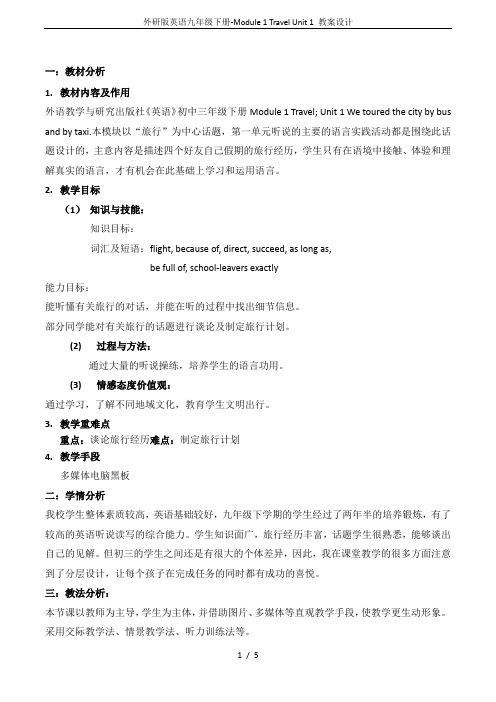
一:教材分析1.教材内容及作用外语教学与研究出版社《英语》初中三年级下册Module 1 Travel; Unit 1 We toured the city by bus and by taxi.本模块以“旅行”为中心话题,第一单元听说的主要的语言实践活动都是围绕此话题设计的,主意内容是描述四个好友自己假期的旅行经历,学生只有在语境中接触、体验和理解真实的语言,才有机会在此基础上学习和运用语言。
2.教学目标(1)知识与技能:知识目标:词汇及短语:flight, because of, direct, succeed, as long as,be full of, school-leavers exactly能力目标:能听懂有关旅行的对话,并能在听的过程中找出细节信息。
部分同学能对有关旅行的话题进行谈论及制定旅行计划。
(2) 过程与方法:通过大量的听说操练,培养学生的语言功用。
(3) 情感态度价值观:通过学习,了解不同地域文化,教育学生文明出行。
3.教学重难点重点:谈论旅行经历难点:制定旅行计划4.教学手段多媒体电脑黑板二:学情分析我校学生整体素质较高,英语基础较好,九年级下学期的学生经过了两年半的培养锻炼,有了较高的英语听说读写的综合能力。
学生知识面广,旅行经历丰富,话题学生很熟悉,能够谈出自己的见解。
但初三的学生之间还是有很大的个体差异,因此,我在课堂教学的很多方面注意到了分层设计,让每个孩子在完成任务的同时都有成功的喜悦。
三:教法分析:本节课以教师为主导,学生为主体,并借助图片、多媒体等直观教学手段,使教学更生动形象。
采用交际教学法、情景教学法、听力训练法等。
四:学法指导:培养学生深入探讨话题的交际能力以及听说技能。
五:设计的基本理念:根据新课标培养学生自主、合作、探究精神,突出语言运用能力的理念而设计。
尊重学生已有知识,帮助建构新知识。
教学过程中突出听说课的特点,以各种教学方法激发学生的兴趣,提高学生的参与能力和学习积极性,让学生在轻松愉快的环境中学英语。
外研版九年级下册英语《module 1 unit 3 language in use》教学设计
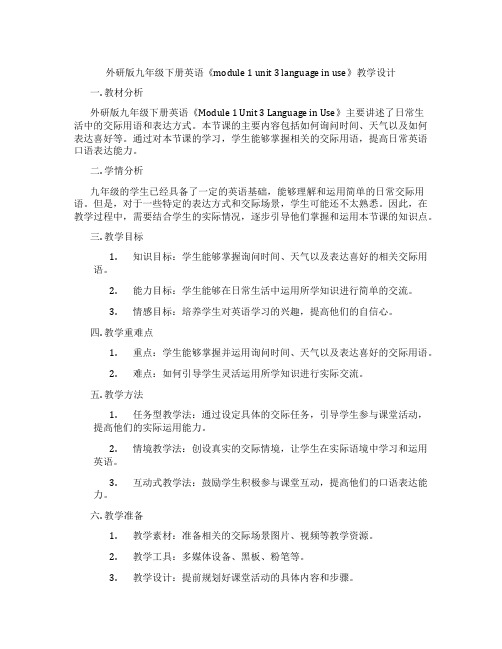
外研版九年级下册英语《module 1 unit 3 language in use》教学设计一. 教材分析外研版九年级下册英语《Module 1 Unit 3 Language in Use》主要讲述了日常生活中的交际用语和表达方式。
本节课的主要内容包括如何询问时间、天气以及如何表达喜好等。
通过对本节课的学习,学生能够掌握相关的交际用语,提高日常英语口语表达能力。
二. 学情分析九年级的学生已经具备了一定的英语基础,能够理解和运用简单的日常交际用语。
但是,对于一些特定的表达方式和交际场景,学生可能还不太熟悉。
因此,在教学过程中,需要结合学生的实际情况,逐步引导他们掌握和运用本节课的知识点。
三. 教学目标1.知识目标:学生能够掌握询问时间、天气以及表达喜好的相关交际用语。
2.能力目标:学生能够在日常生活中运用所学知识进行简单的交流。
3.情感目标:培养学生对英语学习的兴趣,提高他们的自信心。
四. 教学重难点1.重点:学生能够掌握并运用询问时间、天气以及表达喜好的交际用语。
2.难点:如何引导学生灵活运用所学知识进行实际交流。
五. 教学方法1.任务型教学法:通过设定具体的交际任务,引导学生参与课堂活动,提高他们的实际运用能力。
2.情境教学法:创设真实的交际情境,让学生在实际语境中学习和运用英语。
3.互动式教学法:鼓励学生积极参与课堂互动,提高他们的口语表达能力。
六. 教学准备1.教学素材:准备相关的交际场景图片、视频等教学资源。
2.教学工具:多媒体设备、黑板、粉笔等。
3.教学设计:提前规划好课堂活动的具体内容和步骤。
七. 教学过程1.导入(5分钟)通过展示一幅日常生活场景的图片,引导学生思考在日常生活中是如何询问时间、天气以及表达喜好的。
激发学生的学习兴趣,为接下来的课堂活动做铺垫。
2.呈现(10分钟)教师运用PPT展示本节课的主要知识点,包括询问时间、天气以及表达喜好的交际用语。
同时,结合例句和情景,让学生理解和掌握这些表达方式的用法。
【最新】外研版九年级英语下册Module1 Unit1教学设计

Module1 Unit1教学设计一、课程标准:能够谈论自己的度假经历;分享自己的快乐与苦恼。
二、教学目标:知识目标:掌握相关单词、短语,知识点。
能力目标:能听懂对话内容并掌握听力技巧;能够谈论自己的度假经历。
情感态度:能够分享自己的快乐与苦恼。
三、教学重点难点:本单元单词,短语和知识点的用法;四、使用说明与学法指导:1. 大声诵读课文,勾画相关基础知识。
2. 在充分自学的前提下,认真完成学案。
3. 将预习中不能解决的问题标注出来,在课堂中解决。
探究案一.新课导入Let students work in pairs and talk about your favourite type of transportation and why.二.听力训练(多层听)(一)Listen and complete the notes.1. The flight takes about _______ hours.2. Time difference: _______ hours3. Flight number: _________4. From ________ to _________5. Leave at (new time): _________6. Arrive at (new time): _________(二)Listen and answer answer.What are Lingling, Betty and Daming talking about?They are talking about the winter vocation.(三)Listen and choose the best answer.1. Travel is very difficult in winter because .A. it’s too cold to travelB. the Spring Festival makes winter the busiest seasonC. People are too busy2. Tony is coming back by today.A. shipB. planeC. train3. Daming and Betty are looking forward to at the end of the term.A. a big examB. the school-leavers’ partyC. visiting the Summer Palace (四)Listen and fill in the blanks.Lingling: Welcome back, everyone!Betty: Hi, Lingling! How was your holiday?Lingling: Not bad! I went to see my grandparents in Henan Province. The train wasfull of people, and I had to stand for over thre hours_.Betty: Bad luck. Where’s Tony?Daming: He went to stay with his family in the UK. He’s flying back today. But the flight was late.Betty: Why was travel so difficult in winter?Lingling: Well, it’s the busiest season in China because of the Spring Festival.Where did you go, Daming?Daming: We flew direct to Hong Kong-and the plane left a bit late too! It was great fun!三.对话处理听后读:Read and Complete the table.(完成课本activity3)疯狂记忆:如果谁能说出转盘中人物的假期经历,就能得到相应星星。
外研版九年级英语下册教案Module1
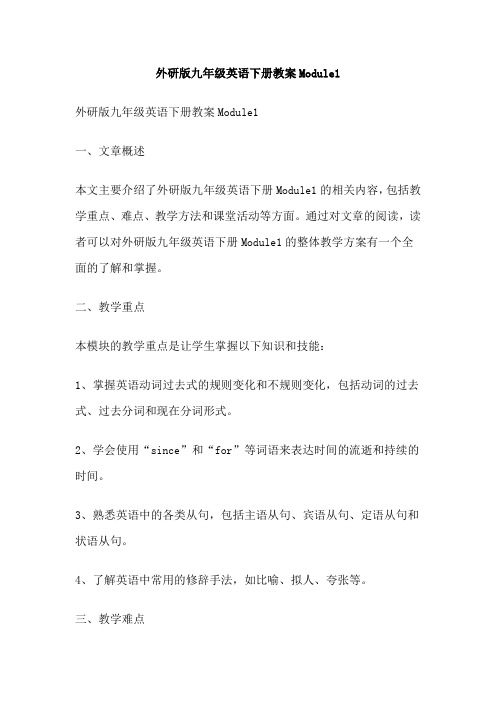
外研版九年级英语下册教案Module1外研版九年级英语下册教案Module1一、文章概述本文主要介绍了外研版九年级英语下册Module1的相关内容,包括教学重点、难点、教学方法和课堂活动等方面。
通过对文章的阅读,读者可以对外研版九年级英语下册Module1的整体教学方案有一个全面的了解和掌握。
二、教学重点本模块的教学重点是让学生掌握以下知识和技能:1、掌握英语动词过去式的规则变化和不规则变化,包括动词的过去式、过去分词和现在分词形式。
2、学会使用“since”和“for”等词语来表达时间的流逝和持续的时间。
3、熟悉英语中的各类从句,包括主语从句、宾语从句、定语从句和状语从句。
4、了解英语中常用的修辞手法,如比喻、拟人、夸张等。
三、教学难点本模块的教学难点在于:1、有些动词的过去式不规则变化难以记忆,需要学生多加练习和巩固。
2、对于初学者来说,“since”和“for”的用法容易混淆,需要教师在课堂上进行详细讲解和示范。
3、从句是英语语法中的一个难点,需要学生有较好的语法基础和逻辑思维能力。
四、教学方法为了更好地实现教学目标,教师可以采用以下教学方法:1、示范讲解:对于重要的语法点和词汇,教师可以进行示范性的讲解和操练,帮助学生理解和掌握。
2、课堂互动:通过课堂互动,如提问、讨论、展示等方式,激发学生的学习兴趣和参与度,提高教学效果。
3、情境教学:通过创设情境,让学生在实际运用中学习和掌握语言知识,如角色扮演、场景模拟等。
4、课外拓展:教师可以布置一些课外拓展活动,如阅读英文原著、观看英文电影、参加英语角等,增加学生的语言输入和输出机会。
五、课堂活动为了提高学生的参与度和学习效果,教师可以设计以下课堂活动:1、小组讨论:将学生分成若干小组,针对某个话题或问题进行讨论,然后进行展示和交流。
2、快速问答:教师提出一些问题,让学生快速回答,锻炼学生的反应能力和口语表达能力。
3、故事接龙:让学生通过故事接龙的方式,运用所学的语法点和词汇编故事,锻炼学生的想象力和语言组织能力。
外研版初中英语九年级下册Module 1 Unit 1 教学设计
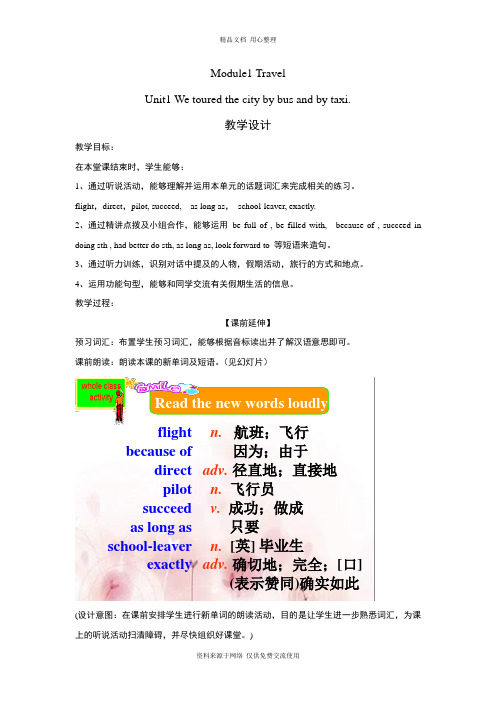
Module1 TravelUnit1 We toured the city by bus and by taxi.教学设计教学目标:在本堂课结束时,学生能够:1、通过听说活动,能够理解并运用本单元的话题词汇来完成相关的练习。
flight ,direct ,pilot, succeed, as long as , school-leaver, exactly.2、通过精讲点拨及小组合作,能够运用 be full of , be filled with, because of , succeed in doing sth , had better do sth, as long as, look forward to 等短语来造句。
3、通过听力训练,识别对话中提及的人物,假期活动,旅行的方式和地点。
4、运用功能句型,能够和同学交流有关假期生活的信息。
教学过程:【课前延伸】预习词汇:布置学生预习词汇,能够根据音标读出并了解汉语意思即可。
课前朗读:朗读本课的新单词及短语。
(见幻灯片)n.航班;飞行因为;由于adv. 径直地;直接地n.飞行员v.成功;做成只要n.[英] 毕业生adv.确切地;完全;[口](表示赞同)确实如此flightbecause ofdirect pilot succeed as long as school-leaverexactlyRead the new words loudly(设计意图:在课前安排学生进行新单词的朗读活动,目的是让学生进一步熟悉词汇,为课上的听说活动扫清障碍,并尽快组织好课堂。
)【课内探究】Step 1: Lead-in :展示自己在北京旅游时在天安门前拍的照片,及长城、故宫、颐和园等旅游景点及出租车、公交车的图片来导入本节课的学习。
(设计意图:用自己的照片及旅游景点的图片来导入新课,容易激发学生的学习兴趣,调动学生学习的积极性。
) Step 2: Pre-listening:taxicoachtrainplane bus shipbike subwayA: Which of these forms of transport do you …①like most?②like least?③travel most often? ④travel least often?B: I like …most.A: Why?B: Because it ’s ...Means of transport(设计意图:在描述旅游经历时,最常见的信息就是乘坐了哪些交通工具,所以本活动结合交通工具图片,以师生问答的形式来谈论同学们最喜欢和最不喜欢乘坐的交通工具,为下面的对话内容做了很好的铺垫) Step 3: While-listeningTask 1: Listen and choose the correct answers. 1. How long did Lingling stand on the train?A. Over 2 hours.B. Over 3 hours.C. Over 4 hours.( ) 2. Why is travel so difficult in winter? A. Because of the weather. B. Because of the people.C. Because of the Spring Festival.( ) 3. What are Daming and Betty looking forward to at the end of the term?A.The school-leavers’ party.B. The school-leav ers’ concert.C. The school-leavers’ exam.( ) 4. When do you think the conversation takes place?A. At the end of the term.B. At the middle of the term.C. At the beginning of the term.Task 2: Listen again and complete the table.Say some sentences with the help of the table.Eg: Lingling went to see her grandparents in Henan Province by train.(设计意图:一听为选择题,比较简单,让学生从整体上感知对话信息,了解对话大意。
外研版英语九下Module1Unit1教案
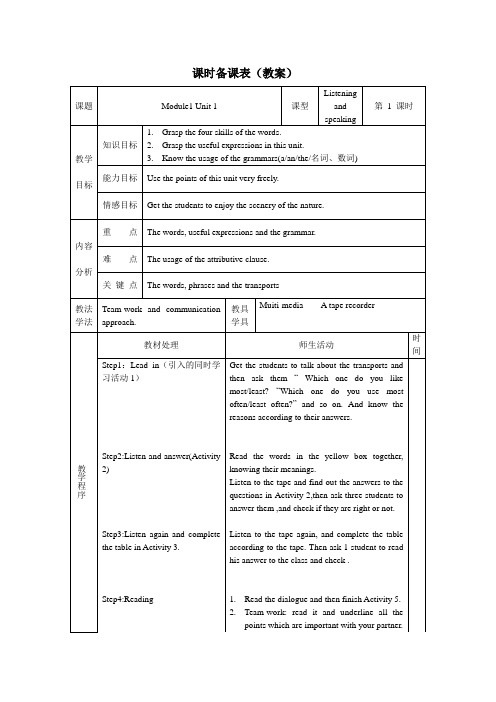
Use the points of this unit very freely.
情感目标
Get the students to enjoy the scenery of the nature.
内容
分析
重点
The words, useful expressions and the grammar.
课时备课表(教案)
课题
Module1 Unit 1
课型
Listening and speaking
第1课时
教学
目标
知识目标
1.Grasp the four skills of the words.
2.Grasp the useful expressions in this unit.
3.Know the usage of the grammars(a/an/the/名词、数词)
难点
The usage of the attributive clause.
关键点
The words, phrases and the transports
教法学法
Team-work and communication approach.
教具
学具
Muiti-media A tape recorder
Be filled with
Because of
Etc
Some phrases in this unit
Have a good holiday
Fly back
At the end of
Plenty of
Etc.
教学后记
2.Team-work: read it and underline all the points which are important with your partner.
外研版英语九年级下册(教学设计)Module 1 Unit 1
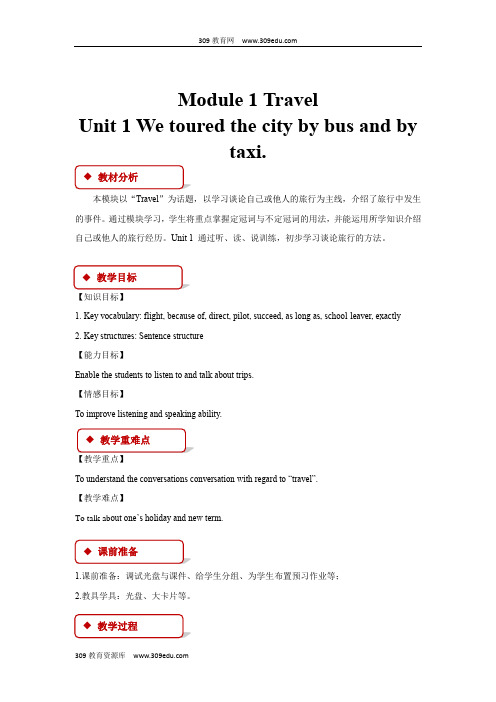
Module 1 TravelUnit 1 We toured the city by bus and bytaxi.本模块以“Travel ”为话题,以学习谈论自己或他人的旅行为主线,介绍了旅行中发生的事件。
通过模块学习,学生将重点掌握定冠词与不定冠词的用法,并能运用所学知识介绍自己或他人的旅行经历。
Unit 1 通过听、读、说训练,初步学习谈论旅行的方法。
【知识目标】1. Key vocabulary: flight, because of, direct, pilot, succeed, as long as, school -leaver, exactly2. Key structures: Sentence structure【能力目标】Enable the students to listen to and talk about trips.【情感目标】To improve listening and speaking ability.【教学重点】 To understand the conversations conversation with regard to “travel”.【教学难点】To talk ab out one’s holiday and new term.1.课前准备:调试光盘与课件、给学生分组、为学生布置预习作业等;2.教具学具:光盘、大卡片等。
◆教学重难点 ◆◆课前准备◆◆教材分析◆教学目标◆教学过程Step1. Words1.Teach the new words and phrases in the lesson with the Chinese explanation and exact pronunciation.2.Show the Chinese meanings to let student answer English correspondents.3.Encourage students to talk about the journey they have done with these new words.Step2. Talking1.Get students to talk about the vehicles they travel by.2.List all the vehicles students have learned.3. Look at the following pictures and talk about the forms of transportation.4.Topic: What’s your favourite type of transportation? Why?1) I most like to travel by _____________.2) I least like to travel by _____________.3) I travel most often by ______________.4) I travel least often by ______________.5.Make a discussion about the advantages and disadvantages of varieties of transportation.6. Talk about these questions and describe your last trip.Where did you go?How did you go there?What did you do there?How was your trip?Did you have a good time?7. Work in pairs to make a complete dialogue.Step3. Learning1.Teach the important words and phrases with their collocations. Encourage students to employ them.2.Teach the language patterns. And then let students make a drills.We toured the city by bus and by taxi.—What did you do during the winter holiday?—I went to see my grandparents in Xi’an.3. Watch the clips and read the text. Give students the guidance:。
外研版英语九年级下册Module 1 Unit 3教案与反思
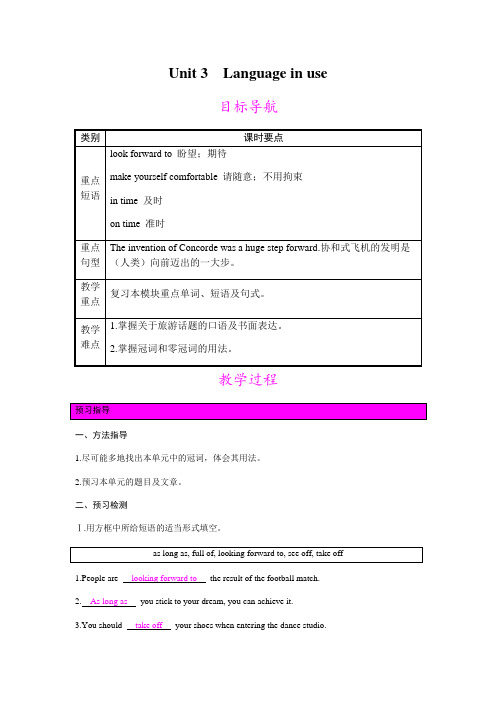
Unit 3Language in use目标导航教学过程一、方法指导1.尽可能多地找出本单元中的冠词,体会其用法。
2.预习本单元的题目及文章。
二、预习检测Ⅰ.用方框中所给短语的适当形式填空。
1.People are looking forward to the result of the football match.2.As long as you stick to your dream, you can achieve it.3.You should take off your shoes when entering the dance studio.4.When we are in trouble, we should be brave enough to deal with problems because our life is not always full of sunshine.5.I went to the station to see off my uncle.Ⅱ.根据句意用所给词的适当形式填空。
1.Many people think Concorde is one of the greatest(great) planes.2.They succeeded in reaching(reach) the top of the mountain.3.We all look forward to meeting(meet)the famous singer.4.I saw some boys playing(play)basketball when I passed the park.Step1情景导入1. Teacher shows some pictures to review the text of Unit 1 and Unit2.2. Students talk about their journeys.Step2语法练习1.全班一起朗读本单元的例句。
外研版九年级英语下册教学设计《Module 1 Unit 1 We toured the city

外研版九年级英语下册教学设计《Module 1 Unit 1 We toured the city by bus andby t》一. 教材分析本节课是外研版九年级英语下册第一模块第一单元的教学内容。
本单元的主题是关于旅游和参观城市。
通过学习本节课,学生将能够掌握有关旅游和参观城市的词汇和表达方式,以及学会如何用英语描述旅游经历。
本节课的主要语言点是现在完成时态的运用,以及一些与旅游相关的词汇和表达方式。
二. 学情分析九年级的学生已经具备了一定的英语基础,能够听懂并运用一些基本的英语句型和词汇。
但是,对于现在完成时态的运用以及一些旅游相关词汇的掌握还存在一定的困难。
因此,在教学过程中,需要针对这些困难进行针对性的讲解和操练。
三. 教学目标1.能够听懂、说出生词和短语,如“tourist attraction”、“by bus and bytrn”等。
2.能够正确运用现在完成时态描述自己的旅游经历。
3.能够用英语简单介绍自己的家乡或所在城市。
四. 教学重难点1.现在完成时态的运用。
2.旅游相关词汇的掌握。
五. 教学方法采用交际法、任务型教学法和情境教学法。
通过创设情境,让学生在真实的语境中学习、运用英语。
同时,通过任务型教学法,让学生在完成任务的过程中,提高自己的英语交际能力。
六. 教学准备1.制作课件,包括旅游相关的图片、视频等。
2.准备旅游相关的词汇卡片。
3.准备现在完成时态的练习题。
七. 教学过程1.导入(5分钟)通过向学生展示一些旅游胜地的图片,引导学生谈论旅游经历,引出本节课的主题。
2.呈现(10分钟)向学生展示本节课的生词和短语,如“tourist attraction”、“by bus and by trn”等,并让学生跟读。
然后,通过播放一段旅游视频,让学生初步感知现在完成时态的运用。
3.操练(15分钟)将学生分成小组,每组选一个旅游地点,用英语进行介绍。
在介绍过程中,要求学生使用现在完成时态。
2019秋外研版九年级英语下册Module1Travel教案

2.引导与启发:在讨论过程中,我将作为一个引导者,帮助学生发现问题、分析问题并解决问题。我会提出一些开放性的问题来启发他们的思考。
3.成果分享:每个小组将选择一名代表来分享他们的讨论成果。这些成果将被记录在黑板上或投影仪上,以便全班文化差异,培养学生对中华优秀传统文化及世界文化的认识,增强跨文化交际意识。
3.思维品质:通过分析旅行话题,培养学生独立思考、解决问题的能力,激发他们的创新思维和批判性思维。
4.学习能力:帮助学生掌握有效的学习策略,提高自主学习、合作学习和探究学习的能力,为终身学习奠定基础。
(三)实践活动(用时10分钟)
1.分组讨论:学生们将分成若干小组,每组讨论一个与旅行相关的实际问题,如制定旅行计划、选择住宿等。
2.实验操作:为了加深理解,我们将进行一个简单的角色扮演活动,模拟在旅行社咨询旅行计划的场景。
3.成果展示:每个小组将向全班展示他们的讨论成果和角色扮演的结果。
(四)学生小组讨论(用时10分钟)
1.理论介绍:首先,我们要了解旅行的基本概念。旅行是人们为了休闲、工作或其他目的,暂时离开日常生活的地方,去到其他地方的活动。它是了解不同文化、拓宽视野的重要方式。
2.案例分析:接下来,我们来看一个具体的案例。这个案例展示了如何制定旅行计划,以及旅行中可能遇到的问题和解决方法。
3.重点难点解析:在讲授过程中,我会特别强调描述旅行计划的词汇和句型,以及现在进行时和将来时的用法。对于难点部分,我会通过举例和比较来帮助大家理解。
2019秋外研版九年级英语下册Module 1 Travel教案
一、教学内容
【最新】外研版九年级英语下册moudle1 unit1教案
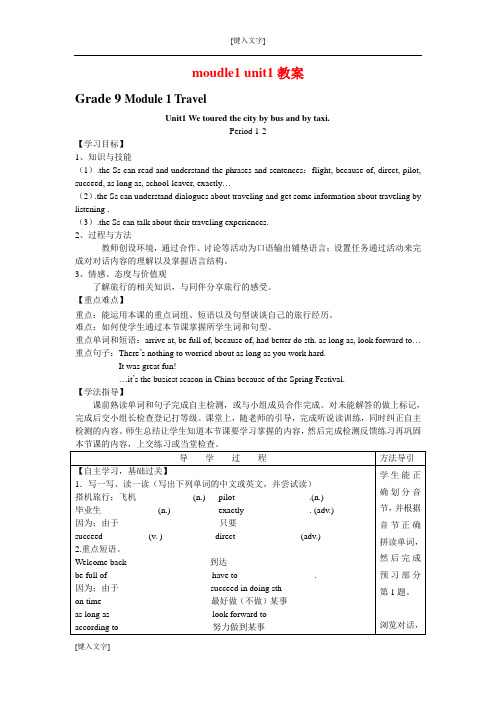
moudle1 unit1教案Grade 9 Module 1 TravelUnit1 We toured the city by bus and by taxi.Period 1-2【学习目标】1、知识与技能(1).the Ss can read and understand the phrases and sentences:flight, because of, direct, pilot, succeed, as long as, school-leaver, exactly…(2).the Ss can understand dialogues about traveling and get some information about traveling by listening .(3).the Ss can talk about their traveling experiences.2、过程与方法教师创设环境,通过合作、讨论等活动为口语输出铺垫语言;设置任务通过活动来完成对对话内容的理解以及掌握语言结构。
3、情感、态度与价值观了解旅行的相关知识,与同伴分享旅行的感受。
【重点难点】重点:能运用本课的重点词组、短语以及句型谈谈自己的旅行经历。
难点:如何使学生通过本节课掌握所学生词和句型。
重点单词和短语:arrive at, be full of, because of, had better do sth. as long as, look forward to…重点句子:There’s nothing to worried about as long as you work hard.It was great fun!…it’s the busiest season in China because of the Spring Festival.【学法指导】课前熟读单词和句子完成自主检测,或与小组成员合作完成。
初中英语外研版九年级下册高效课堂资料M1U1 教学设计
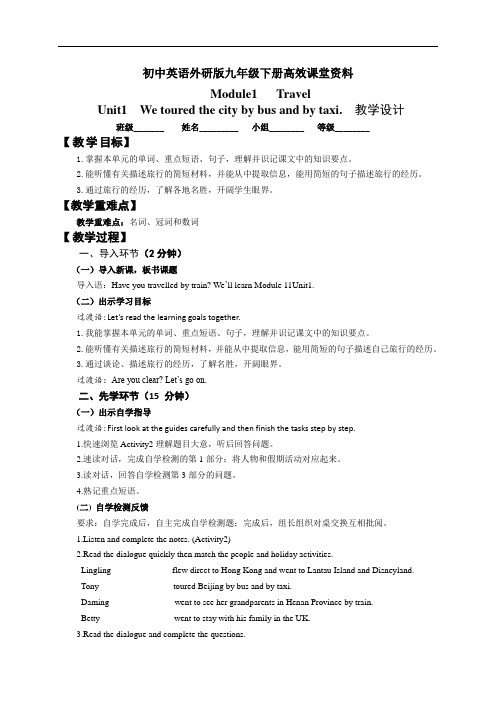
初中英语外研版九年级下册高效课堂资料Module1 TravelUnit1 We toured the city by bus and by taxi. 教学设计班级_______ 姓名_________ 小组________ 等级________【教学目标】1.掌握本单元的单词、重点短语、句子,理解并识记课文中的知识要点。
2.能听懂有关描述旅行的简短材料,并能从中提取信息,能用简短的句子描述旅行的经历。
3.通过旅行的经历,了解各地名胜,开阔学生眼界。
【教学重难点】教学重难点:名词、冠词和数词【教学过程】一、导入环节(2分钟)(一)导入新课,板书课题导入语:Have you travelled by train? We’ll learn Module 11Unit1.(二)出示学习目标过渡语:Let’s read the learning goals together.1.我能掌握本单元的单词、重点短语、句子,理解并识记课文中的知识要点。
2.能听懂有关描述旅行的简短材料,并能从中提取信息,能用简短的句子描述自己旅行的经历。
3.通过谈论、描述旅行的经历,了解名胜,开阔眼界。
过渡语:Are you clear? Let’s go on.二、先学环节(15 分钟)(一)出示自学指导过渡语:First look at the guides carefully and then finish the tasks step by step.1.快速浏览Activity2理解题目大意,听后回答问题。
2.速读对话,完成自学检测的第1部分:将人物和假期活动对应起来。
3.读对话,回答自学检测第3部分的问题。
4.熟记重点短语。
(二) 自学检测反馈要求:自学完成后,自主完成自学检测题;完成后,组长组织对桌交换互相批阅。
1.Listen and complete the notes. (Activity2)2.Read the dialogue quickly then match the people and holiday activities.Lingling flew direct to Hong Kong and went to Lantau Island and Disneyland.Tony toured Beijing by bus and by taxi.Daming went to see her grandparents in Henan Province by train.Betty went to stay with his family in the UK.3.Read the dialogue and complete the questions.(1) Is the train that Lingling took filled with people? ________________________________________(2) Tony is going back by plane, isn’t he? _______________________________________________(3) 翻译句子a. It’s the busiest season in China because of the Spring Festival.______________________________b. There’s nothing to worry about as long as you work hard. _________________________________(4) What are Daming and Betty looking forward to at the end of the term? ______________________点拨:3. (1) Yes, it is. (2) Yes, he is.(3) a.因为春节,在中国这是交通最繁忙的季节。
外研版英语九年级下册《Module 1 Travel》教学设计

外研版英语九年级下册《Module 1 Travel》教学设计一. 教材分析外研版英语九年级下册《Module 1 Travel》主要介绍了旅游的主题。
通过本模块的学习,学生能够掌握关于旅游的相关词汇和表达方式,了解不同国家的旅游特色,提高他们的语言运用能力和跨文化交际意识。
本模块包括三个单元,每个单元都包含听、说、读、写等方面的内容,旨在全面提高学生的英语素养。
二. 学情分析九年级的学生已经具备了一定的英语基础,对于日常生活中的词汇和表达方式有所了解。
但是,对于旅游这一主题的专业词汇和表达方式可能较为陌生。
因此,在教学过程中,需要帮助学生建立起旅游主题的词汇体系,同时引导他们运用已有的英语知识来表达关于旅游的内容。
三. 教学目标1.知识目标:学生能够掌握关于旅游的相关词汇和表达方式,了解不同国家的旅游特色。
2.能力目标:学生能够运用英语进行旅游主题的听、说、读、写活动,提高他们的语言运用能力。
3.情感目标:通过学习本模块,学生能够培养对旅游的兴趣,提高他们的跨文化交际意识。
四. 教学重难点1.重点:旅游主题的词汇和表达方式的掌握。
2.难点:如何运用英语进行旅游主题的听、说、读、写活动,以及跨文化交际能力的培养。
五. 教学方法1.交际法:通过模拟真实的旅游场景,引导学生进行听、说、读、写活动,提高他们的语言运用能力。
2.任务型教学法:通过完成旅游相关的任务,激发学生的学习兴趣,培养他们的跨文化交际意识。
3.情境教学法:通过创设旅游情境,帮助学生理解和运用旅游相关的词汇和表达方式。
六. 教学准备1.教材:外研版英语九年级下册《Module 1 Travel》。
2.多媒体教学设备:用于展示旅游相关的图片、视频等材料。
3.旅游卡片:用于模拟旅游场景的听、说、读、写活动。
4.旅游小故事:用于激发学生的学习兴趣和跨文化交际意识。
七. 教学过程1.导入(5分钟)利用多媒体展示不同国家的旅游景点,引导学生进行观察和思考,激发他们对旅游的兴趣。
外研版英语(新标准)九年级下册《Module 1 Travel》教学设计

合作学习策略:能够与同学交流自己的旅行经历;分享学习策略。
文化意识:
了解不同的自然环境与文化,增强民族自豪感。
教学重点及难点
重点:
1.掌握课文内容相关的词汇句型。
2.掌握名词、冠词及数词。
难点:
能听懂并记录航班信息。
能叙述假期旅行中的经历。
能用一个短剧描述旅行中发生的事。
Step4:
A.听录音并且大声地,有感情地跟读课文;
B.分组合作,把这个短剧演出来。鼓励学生对剧本进行创新,把短剧做适当的改编。在全班展示表演。
。
A.本活动旨在让学生通过模仿,不仅对短剧有了感性的认识,而且提高学生的语音语调水平。
B.该活动旨在调动学生的学习积极性,让不同层次水平的学生都能在其中有所表现,也培养了学生之间的团队合作意识。
本语篇是一个剧本,本活动通过让学生略读材料,快速把握该剧的主要大意。
Step3:
Scan the text and choose the proper answers.
查读课文:
个体活动,学生快速扫描式阅读文章,选择答案;
全班核对答案,请学生指出文中支持所选答案的句子。
本活动旨在检测学生对文章细节的理解能力。鼓励并引导学生合作学习。不仅懂得答案,还要掌握阅读技巧。
2.语音:能正确地划分意群。
3.语法:复习名词、冠词及数词。
语言技能目标:
听:能听懂关于旅行的对话及听懂航班信息。
说:能讨论关于假期的生活。
读:能读懂假期旅行中遇到小插曲的短剧,能根据相关信息预测文章内容。
写:能根据你的旅途经历编写一个短剧。
情感目标:渗透正确的价值观,培养助人为乐的优秀品德。
外研版英语九年级下册Module1 Unit1 精品教案
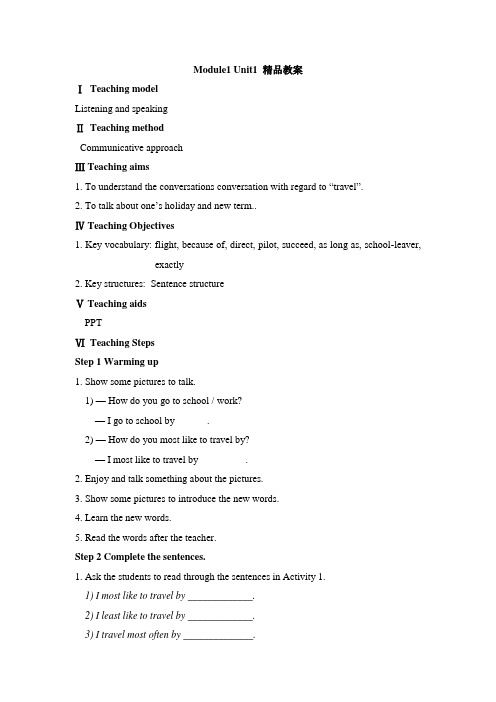
Module1 Unit1 精品教案ⅠTeaching modelListening and speakingⅡTeaching methodCommunicative approachⅢ Teaching aims1. To understand the conversations conversation with regard to “travel”.2. To talk about one’s holiday and new term..Ⅳ Teaching Objectives1. Key vocabulary: flight, because of, direct, pilot, succeed, as long as, school-leaver,exactly2. Key structures:Sentence structureⅤ Teaching aidsPPTⅥTeaching StepsStep 1 Warming up1. Show some pictures to talk.1) — How do you go to school / work?— I go to school by ______.2) — How do you most like to travel by?— I most like to travel by _________.2. Enjoy and talk something about the pictures.3. Show some pictures to introduce the new words.4. Learn the new words.5. Read the words after the teacher.Step 2 Complete the sentences.1. Ask the students to read through the sentences in Activity 1.1) I most like to travel by _____________.2) I least like to travel by _____________.3) I travel most often by ______________.4) I travel least often by ______________.2. Complete the sentences so they are true for you.3. Ask the students to check their answer with a partner.4. Call back the answers from the whole class and check the answers.Step 3 Listening practice.1. Ask the students to read through the sentences in Activity2.1) The flight takes about __________ hours.2) Time difference: __________ hours.3) Flight number: __________4) From _________ to _________5) Leave at (new time): _________6) Arrive at (new time): _________Keys: 10, 8, CA938, London, Beijing, 11:30, 5:30 p.m.2. Play the tape and ask the students to listen to the tape carefully.3. Listen and complete the notes.4. Ask the students to check their answer with a partner.5. Call back the answers from the whole class and check the answers.Step 4 Listen and read.1. Ask the students to listen and read the conversation silently.When you listen to the recording, try to note down the key information. Your notes will then help you retell the main information.2. Now complete the table.Holiday activitiesLingling went to see her grandparents in Henan Province by trainTonyDamingBetty4. Ask the students to check their answer with a partner.5. Call back the answers from the whole class and check the answers.Keys:。
外研版初三英语下册Module-1教案设计
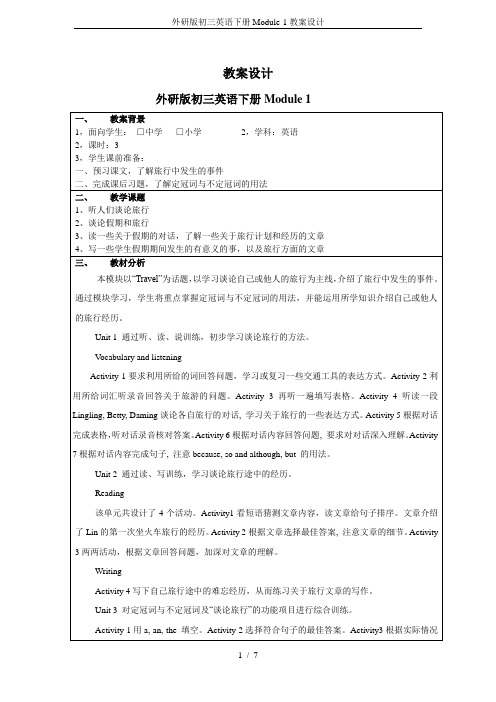
教案设计外研版初三英语下册Module 1完成句子。
Activity 4看图完成表格, 要求学生能看懂飞机票。
Activity 5听录音完成表格。
Activity 6根据表格回答问题。
Activity 7阅读短文完成表格,写出文中介绍飞机的优缺点。
Activity 8再次阅读Activity 7的短文把数字与事件连线。
Around the world介绍了飞行员Charles Lindbergh第一次飞渡大西洋的经历。
Module task要求学生描述一次旅行经历。
四、教学方法Unit 1 通过听、读、说训练,初步学习谈论旅行的方法。
Unit 2 通过读、写训练,学习谈论旅行途中的经历。
Unit 3 对定冠词与不定冠词及“谈论旅行”的功能项目进行综合训练。
五、教学过程第一课时Unit 1 The flight was late.Step 1 Greeting找一段回声的录音,课堂放给学生听。
【百度视频】回声的录音/v_show/id_XMzAxNDQ5NTUy.htmlStep 2 Warming up and lead-inIn this procedure, try to make students understand the new words. Encourage the students to make a conversation in pairs.Bike car subway coachtaxi train airplane shipStep 3 Listening and speakingAsk students to listen and answer the questions in activity 2.ListeningCheck the answers with the class. Then play the tape again and ask the students to complete the table in activity 3.SpeakingAfter finishing the listening exercises, let the students practice speaking.Step 4 Listening and readingIn this procedure, let the students read the conversation and do Activity 6 and 7.Step 5 PairworkAsk students to listen to and say the conversation in activity 8 and then read the conversation in activity 9 again, paying attention to the intonations.Homework1.Learn the new words by heart.2.Act out the conversation in groups.3.Finish off the workbook exercises 1-7.第二课时Unit 2 You’re sitting in my seat.Step 1 GreetingStep 2 RevisionEncourage students to act out the dialogue in Unit 1.Step 3 Warming up and leading in找一段回声的录音,课堂放给学生听。
- 1、下载文档前请自行甄别文档内容的完整性,平台不提供额外的编辑、内容补充、找答案等附加服务。
- 2、"仅部分预览"的文档,不可在线预览部分如存在完整性等问题,可反馈申请退款(可完整预览的文档不适用该条件!)。
- 3、如文档侵犯您的权益,请联系客服反馈,我们会尽快为您处理(人工客服工作时间:9:00-18:30)。
Unit 1We toured the city by bus and by taxi.目标导航教学过程预习指导:一、方法指导1.学生自主预习本单元中新的单词和短语,注意单词的发音和意思。
2.了解本单元话题,搜集相关资料,预习Activity 3中的对话。
二、预习检测Ⅰ.根据句意及汉语提示完成单词。
1.Jack succeeded(成功) in passing the exam at last.2.She drove directly(直接地) to the school after work.3.I’d like to learn about my flight(航班) from London to Tokyo.4.I want to be a pilot(飞行员) in the future.5.I can’t remember when exactly(确切地) she left the city.Ⅱ.根据句意用所给词的适当形式填空。
1.Mike succeeded in getting(get) to the top of the mountain.2.You’d better not go(not go) there by bike because it’s far away.3.They’re looking forward to meeting(meet) you.4.Chang An Avenue is one of the busiest(busy) streets in Beijing.5.There’s something to buy(buy) here as long as you have enough money.课堂教学:Step1情景导入Teacher shows some pictures of the way that people travel and guides students to talk.T: How do you go to school?Ss: I go to school by car/bike/bus....T: How do you most like to travel by?Ss: I most like to travel by car/boat/plane....Step2听前准备1.学习新的单词及短语。
2.学生根据自身实际情况,完成Activity 1中的问题。
Step3听与读1.听录音,完成Activity 2中的笔记并核对答案。
2.学生快速阅读对话,完成Activity 3中的表格。
3.学生分角色朗读对话,回答Activity 4中的问题。
4.先熟悉Activity 5中的单词,再完成Activity 5中的练习。
5.请几位学生分享答案,并全班核对答案。
限时训练:单项填空(B)1.—Is the schoolbag under the desk yours?—No, it’s my_______. He left it there just now.A. brotherB. brother’sC. brothers’D. brothers(C)2.—After PE, I often feel very thirsty. —Why not buy some _______to drink?A. breadB. noodlesC. apple juiceD. teas(A)3.—How far is it from Tianjin to Changsha?—It is a _______ flight from Tianjin to Changsha.A.2-hour-longB.2-hours-longC.2 hours’ longD.2 hour long(C)4.Could you please get me some _______? I’m hungry.A. appleB. waterC. breadD. egg(C)5.In this test, we’re asked to write a passage of about _______.A. 80-wordsB. 80-wordC. 80 wordsD. 80 words’Step4发音与口语训练1.试读Activity 6中的对话,并标出停顿。
2.听录音并检查预测是否正确。
3.再次听录音并跟读。
Step5合作探究:谈论寒假1.询问学生在寒假做了什么。
—What did you do during the winter holiday?—I went to see my grandparents in Xi’an.2.谈论旅途中发生的事情。
The train was full of people and I had to stand for three hours!板书设计:教学反思本节课是新学期的第一课,以学生“寒假的活动”作为话题,切入学生的假期生活,激发了学生的兴趣,调动了学生的积极性,有利于师生间的沟通和交流。
本节课难点在于名词的句法功能,老师在讲解时根据情况要适当补充句子结构知识;另外本节课的知识点中有些是高频考点,比如succeed in doing,老师应该加强训练,帮助学生熟练掌握该知识点。
Unit 2It’s a long story.目标导航类别课时要点重点单词sir n.先生;长官officer n.军官;官员;警察stupid adj.笨的;糊涂的jacket n.短上衣;夹克教学过程一、方法指导1.学生自主预习本单元中新的单词和短语,注意单词的发音,并掌握其意思。
2.了解课文主题,搜集相关资料,预习Activity 2中的对话内容。
二、预习检测Ⅰ.根据句意及汉语提示完成单词。
1.Thank you,sir(先生).2.Would you like to try this jacket(夹克) on?3.The officer(军官) ordered them to stand in a line.4.How could you be so stupid(糊涂的) to think so?5.I was surprised(惊奇的) to see my first teacher on the railway station.Ⅱ.根据句意用所给词的适当形式填空。
1.She is afraid to go(go) out alone late at night.2.You’d better wait(wait) for her on the station platform.3.He is surprised(surprise) to see his parents in the programme.4.She kindly offered to change(change) her seat with the old woman.5.He is in a bad temper this morning. Take care not to step(not step) on his toe.Step1情景导入Teacher shows students familiar pictures of travel and encourages students to talk about their travel stories.T: Do you like travelling?Ss: Yes, we do.T: I like travelling too, and I like taking photos. Here are some photos to you. Do you know where they are?Ss: In a train.T: Have you ever taken a train? Did you have any stories during your trip? Have you ever helped an old man? Today we will study a long story happened during a trip.Step2阅读前引导学生了解Activity 1中的短语,鼓励学生发散思维,大胆预测阅读内容。
Step3快速阅读1.快速阅读课文,了解文章大意,检查预测内容。
2.请几位学生概述文章大意。
Step4精读课文1.精读课文,理解对话的内容。
2.了解Activity 3中的问题,选出正确的答案,然后全班核对答案。
3.老师讲解对话中的语言点。
4.再次阅读。
英译汉1. Let’s have a look at your ticket.让我查看下你的车票。
2. I’ll take your seat in Car 9.我去9号车厢坐你的位子吧。
3. I’ll have someone to talk to on the long journey.在漫长的旅途中,我有人可以说话了。
4. What a surprise!太意外了!Step5合作探究分组讨论并回答下列问题:1. How does Li Lin feel about this trip? Why? Do you think you will ever have the same feelings about a trip?2. Was Li Lin right to ask the elderly man to move?3. What do you think of the elderly man’s be haviour?4. What do you usually do if you see someone standing on a bus or a train?参考示例Step6写作训练让学生分享故事,并做记录,然后同伴交换故事并订正对方的错误。
教学反思本节课中,采用了创设情境学习的方法,鼓励学生大胆地说英语,对学生在学习过程中犯的错误采取宽容的态度。
根据教材中的情境,真实再现于课堂并创设新的情境,如“谈论自己的旅行”等,使学生积极参与,到讲台上锻炼英语表达的能力和胆量。
提高学生英语口语交际的能力,培养学生灵活运用英语的习惯。
Unit 3Language in use目标导航教学过程一、方法指导1.尽可能多地找出本单元中的冠词,体会其用法。
2.预习本单元的题目及文章。
二、预习检测Ⅰ.用方框中所给短语的适当形式填空。
1.People are looking forward to the result of the football match.2.As long as you stick to your dream, you can achieve it.3.You should take off your shoes when entering the dance studio.4.When we are in trouble, we should be brave enough to deal with problems because our life is not always full of sunshine.5.I went to the station to see off my uncle.Ⅱ.根据句意用所给词的适当形式填空。
